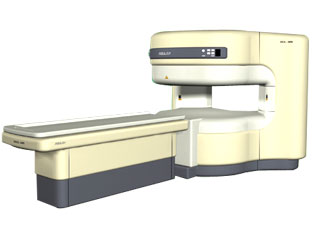 | Info
Sheets |
| | | | | | | | | | | | | | | | | | | | | | | | |
 | Out-
side |
| | | | |
|
| | | | | |  | Searchterm 'Sequences' was also found in the following services: | | | | |
|  |  |
| |
|

From ISOL Technology
'RELAX is open type MRI system created by making up for the weakness of existing conventional MR systems and applying the strength and the application of the middle to high field MR without uncompromising the image quality.
RELAX offers you a premium mix of form, performance and functionality that are patient and user
friendly beyond comparison.
- New breed of MRI pursuing
- patients comfort'
Device Information and Specification CLINICAL APPLICATION Whole body lower than 2.4 m from the iso-center | |  | | | |
|  |  | Searchterm 'Sequences' was also found in the following services: | | | | |
|  |  |
| |
|
Refocused GRE sequences use a refocusing gradient in the phase encoding direction during the end module to maximize (refocus) remaining xy- (transverse) magnetization at the time when the next excitation is due, while the other two gradients are, in any case, balanced.
When the next excitation pulse is sent into the system with an opposed phase, it tilts the magnetization in the α direction. As a result the z-magnetization is again partly tilted into the xy-plane, while the remaining xy-magnetization is tilted partly into the z-direction.
Companies use different acronyms to describe certain techniques.
Different terms for these gradient echo pulse sequences
R-GRE Refocused Gradient Echo,
FAST Fourier Acquired Steady State,
FFE Fast Field echo,
FISP Fast Imaging with Steady State Precession,
F-SHORT SHORT Repetition Technique Based on Free Induction Decay,
GFEC Gradient Field Echo with Contrast,
GRASS Gradient Recalled Acquisition in Steady State,
ROAST Resonant Offset Averaging in the Steady State,
SSFP Steady State Free Precession.
STERF Steady State Technique with Refocused FID
In this context, 'contrast' refers to the pulse sequence, it does not mean enhancement with a contrast agent. | |  | |
• View the DATABASE results for 'Refocused Gradient Echo Sequence' (9).
| | | | |
|  | |  |  |  |
| |
|
| |  | |
• View the DATABASE results for 'Refocusing' (22).
| | | | |  Further Reading: Further Reading: | Basics:
|
|
| |
|  |  | Searchterm 'Sequences' was also found in the following services: | | | | |
|  |  |
| |
|
Respiratory compensation reduces motion artifacts due to breathing. The approach is to reassign the echoes that are sensitive to respiratory motion in the central region of k-space. The outer lines of phase encoding normally contain the echoes where the motion from expiration is the greatest. The central portion of k-space will have encoded the echoes where inspiration and expiration are minimal. By a bellows device fixed to the abdomen, monitoring of the diaphragm excursion is possible. Respiratory compensation does not increase scan time with most systems.
An advantage of very fast sequences is the possibility of breath holding during the acquisition to eliminate motion artifacts.
Breath hold is commonly used on most abdominal studies where images are acquired using gradient echo-based sequences during a brief inspiratory period (20-30 seconds). To enhance the breath holding endurance of the patient, connecting the patient to oxygen at a 1-liter flow rate via a nasal cannula has been shown to be helpful.
Also called PEAR, Respiratory Trigger, Respiratory Gating, PRIZE, FREEZE, Phase Reordering.
See also Phase Encoding Artifact Reduction, Respiratory Ordered Phase Encoding. | |  | |
• View the DATABASE results for 'Respiratory Compensation' (4).
| | | | |  Further Reading: Further Reading: | News & More:
|
|
| |
|  |  | Searchterm 'Sequences' was also found in the following services: | | | | |
|  |  |
| |
|
| |  | |
• View the DATABASE results for 'Reverse Fast Imaging with Steady State Precession' (2).
| | | | |  Further Reading: Further Reading: | News & More:
|
|
| |
|  | |  |  |
|  | |
|  | | |
|
| |
 | Look
Ups |
| |